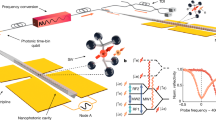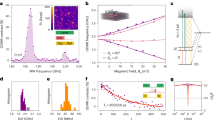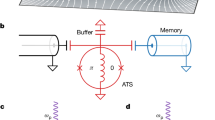Abstract
Large-scale superconducting quantum computers require the high-fidelity control and readout of large numbers of qubits at millikelvin temperatures, resulting in a massive input–output bottleneck. Cryo-electronics based on complementary metal–oxide–semiconductor technology could provide a scalable and versatile solution. However, detrimental effects due to cross-coupling between the qubits and the electronic and thermal noise generated during cryo-electronics operation need to be avoided. Here we report a low-power radio-frequency multiplexing cryo-electronics system that operates below 15 mK with a minimal cross-coupling. We benchmark its performance by interfacing the system with a superconducting qubit and observe that the qubit’s relaxation times are unaffected, whereas the coherence times are marginally affected in both static and dynamic operations. Using the multiplexer, single-qubit gate fidelities above 99.9%—that is, above the threshold for surface-code-based quantum error correction—can be achieved with appropriate thermal filtering. We also demonstrate time-division multiplexing capabilities by dynamically windowing calibrated qubit control pulses.
This is a preview of subscription content, access via your institution
Access options
Access Nature and 54 other Nature Portfolio journals
Get Nature+, our best-value online-access subscription
$29.99 / 30 days
cancel any time
Subscribe to this journal
Receive 12 digital issues and online access to articles
$119.00 per year
only $9.92 per issue
Buy this article
- Purchase on Springer Link
- Instant access to full article PDF
Prices may be subject to local taxes which are calculated during checkout




Similar content being viewed by others
Data availability
The data that support the findings of this study are available from the corresponding author upon reasonable request.
Code availability
The codes that support the findings of this study are available from the corresponding author upon reasonable request.
References
Montanaro, A. Quantum algorithms: an overview. npj Quantum Inf. 2, 15023 (2016).
Preskill, J. Quantum computing in the NISQ era and beyond. Quantum 2, 79 (2018).
Bravyi, S., Gosset, D. & König, R. Quantum advantage with shallow circuits. Science 362, 308–311 (2018).
Daley, A. J. et al. Practical quantum advantage in quantum simulation. Nature 607, 667–676 (2022).
Zhong, H.-S. et al. Quantum computational advantage using photons. Science 370, 1460–1463 (2020).
Bruzewicz, C. D., Chiaverini, J., McConnell, R. & Sage, J. M. Trapped-ion quantum computing: progress and challenges. Appl. Phys. Rev. 6, 021314 (2019).
Mills, A. R. et al. Two-qubit silicon quantum processor with operation fidelity exceeding 99%. Sci. Adv. 8, eabn5130 (2022).
Gong, M. et al. Quantum walks on a programmable two-dimensional 62-qubit superconducting processor. Science 372, 948–952 (2021).
Wang, C. et al. Towards practical quantum computers: transmon qubit with a lifetime approaching 0.5 milliseconds. npj Quantum Inf. 8, 3 (2022).
Zhao, Y. et al. Realization of an error-correcting surface code with superconducting qubits. Phys. Rev. Lett. 129, 030501 (2022).
Krinner, S. et al. Realizing repeated quantum error correction in a distance-three surface code. Nature 605, 669–674 (2022).
Arute, F. et al. Quantum supremacy using a programmable superconducting processor. Nature 574, 505–510 (2019).
Wu, Y. et al. Strong quantum computational advantage using a superconducting quantum processor. Phys. Rev. Lett. 127, 180501 (2021).
Zhu, Q. et al. Quantum computational advantage via 60-qubit 24-cycle random circuit sampling. Sci. Bull. 67, 240–245 (2022).
Krantz, P. et al. A quantum engineer’s guide to superconducting qubits. Appl. Phys. Rev. 6, 021318 (2019).
Krinner, S. et al. Engineering cryogenic setups for 100-qubit scale superconducting circuit systems. EPJ Quantum Technol. 6, 2 (2019).
Córcoles, A. D. et al. Exploiting dynamic quantum circuits in a quantum algorithm with superconducting qubits. Phys. Rev. Lett. 127, 100501 (2021).
Fowler, A. G., Mariantoni, M., Martinis, J. M. & Cleland, A. N. Surface codes: towards practical large-scale quantum computation. Phys. Rev. A 86, 032324 (2012).
Gidney, C. & Ekerå, M. How to factor 2048 bit RSA integers in 8 hours using 20 million noisy qubits. Quantum 5, 433 (2021).
Franke, D. P., Clarke, J. S., Vandersypen, L. M. K. & Veldhorst, M. Rent’s rule and extensibility in quantum computing. Microprocess. Microsyst. 67, 1–7 (2019).
Reilly, D. J. Challenges in scaling-up the controlinterface of a quantum computer. In 2019 IEEE International Electron Devices Meeting (IEDM) 31.7.1–31.7.6 (IEEE, 2019).
Patra, B. et al. Cryo-CMOS circuits and systems for quantum computing applications. IEEE J. Solid-State Circuits 53, 309–321 (2018).
Reilly, D. J. Engineering the quantum-classical interface of solid-state qubits. npj Quantum Inf. 1, 15011 (2015).
Ward, D. R., Savage, D. E., Lagally, M. G., Coppersmith, S. N. & Eriksson, M. A. Integration of on-chip field-effect transistor switches with dopantless Si/SiGe quantum dots for high-throughput testing. Appl. Phys. Lett. 102, 213107 (2013).
Al-Taie, H. et al. Cryogenic on-chip multiplexer for the study of quantum transport in 256 split-gate devices. Appl. Phys. Lett. 102, 243102 (2013).
Puddy, R. K. et al. Multiplexed charge-locking device for large arrays of quantum devices. Appl. Phys. Lett. 107, 143501 (2015).
Pauka, S. J. et al. Characterizing quantum devices at scale with custom cryo-CMOS. Phys. Rev. Appl. 13, 054072 (2020).
Pauka, S. J. et al. A cryogenic CMOS chip for generating control signals for multiple qubits. Nat. Electron. 4, 64–70 (2021).
Paquelet Wuetz, B. et al. Multiplexed quantum transport using commercial off-the-shelf CMOS at sub-kelvin temperatures. npj Quantum Inf. 6, 43 (2020).
Van Dijk, J. P. G. et al. A scalable cryo-CMOS controller for the wideband frequency-multiplexed control of spin qubits and transmons. IEEE J. Solid-State Circuits 55, 2930–2946 (2020).
Bardin, J. C. et al. Design and characterization of a 28-nm bulk-CMOS cryogenic quantum controller dissipating less than 2 mW at 3 K. IEEE J. Solid-State Circuits 54, 3043–3060 (2019).
Kang, K. et al. A cryo-CMOS controller IC with fully integrated frequency generators for superconducting qubits. In 2022 IEEE International Solid-State Circuits Conference (ISSCC) 65, 362–364 (IEEE, 2022).
Yeh, J.-H. & Anlage, S. M. In situ broadband cryogenic calibration for two-port superconducting microwave resonators. Rev. Sci. Instrum. 84, 034706 (2013).
Wagner, A., Ranzani, L., Ribeill, G. & Ohki, T. A. Demonstration of a superconducting nanowire microwave switch. Appl. Phys. Lett. 115, 172602 (2019).
Naaman, O., Abutaleb, M. O., Kirby, C. & Rennie, M. On-chip Josephson junction microwave switch. Appl. Phys. Lett. 108, 112601 (2016).
Pechal, M. et al. Superconducting switch for fast on-chip routing of quantum microwave fields. Phys. Rev. Appl. 6, 024009 (2016).
Hornibrook, J. M. et al. Cryogenic control architecture for large-scale quantum computing. Phys. Rev. Appl. 3, 024010 (2015).
Lecocq, F. et al. Control and readout of a superconducting qubit using a photonic link. Nature 591, 575–579 (2021).
McDermott, R. et al. Quantum–classical interface based on single flux quantum digital logic. Quantum Sci. Technol. 3, 024004 (2018).
Gonzalez-Zalba, M. F. et al. Scaling silicon-based quantum computing using CMOS technology. Nat. Electron. 4, 872–884 (2021).
Potočnik, A. et al. Millikelvin temperature cryo-CMOS multiplexer for scalable quantum device characterisation. Quantum Sci. Technol. 7, 015004 (2022).
Ruffino, A. A cryo-CMOS chip that integrates silicon quantum dots and multiplexed dispersive readout electronics. Nat. Electron. 5, 53–59 (2022).
Schaal, S. et al. A CMOS dynamic random access architecture for radio-frequency readout of quantum devices. Nat. Electron. 2, 236–242 (2019).
Beckers, A. et al. Characterization and modeling of 28-nm FDSOI CMOS technology down to cryogenic temperatures. Solid-State Electron. 159, 106–115 (2019).
Yang, C. H. et al. Operation of a silicon quantum processor unit cell above one kelvin. Nature 580, 350–354 (2020).
Verjauw, J. et al. Path toward manufacturable superconducting qubits with relaxation times exceeding 0.1 ms. npj Quantum Inf. 8, 93 (2022).
Blais, A., Grimsmo, A. L., Girvin, S. M. & Wallraff, A. Circuit quantum electrodynamics. Rev. Mod. Phys. 93, 025005 (2021).
Yan, F. et al. The flux qubit revisited to enhance coherence and reproducibility. Nat. Commun. 7, 12964 (2016).
Gustavsson, S. et al. Suppressing relaxation in superconducting qubits by quasiparticle pumping. Science 354, 1573–1577 (2016).
Heinsoo, J. et al. Rapid high-fidelity multiplexed readout of superconducting qubits. Phys. Rev. Appl. 10, 034040 (2018).
Zhang, Z. et al. A d.c.-32GHz 7-bit passive attenuator with capacitive compensation bandwidth extension technique in 55 nm CMOS. In 2020 IEEE/MTT-S International Microwave Symposium (IMS) 1303–1306 (IEEE, 2020).
Knill, E. et al. Randomized benchmarking of quantum gates. Phys. Rev. A 77, 012307 (2008).
Magesan, E., Gambetta, J. M. & Emerson, J. Scalable and robust randomized benchmarking of quantum processes. Phys. Rev. Lett. 106, 180504 (2011).
Vepsäläinen, A. et al. Improving qubit coherence using closed-loop feedback. Nat. Commun. 13, 1932 (2022).
Chen, Z. Metrology of Quantum Control and Measurement in Superconducting Qubits. PhD thesis, Univ. of California, Santa Barbara (2018).
McKay, D. C., Wood, C. J., Sheldon, S., Chow, J. M. & Gambetta, J. M. Efficient Z gates for quantum computing. Phys. Rev. A 96, 022330 (2017).
Motzoi, F., Gambetta, J. M., Rebentrost, P. & Wilhelm, F. K. Simple pulses for elimination of leakage in weakly nonlinear qubits. Phys. Rev. Lett. 103, 110501 (2009).
Johansson, J. R., Nation, P. D. & Nori, F. QuTiP 2: a Python framework for the dynamics of open quantum systems. Comput. Phys. Commun. 184, 1234–1240 (2013).
Shan, Z., Zhu, Y. & Zhao, B. A high-performance compilation strategy for multiplexing quantum control architecture. Sci. Rep. 12, 7132 (2022).
Rasmussen, S. E. et al. Superconducting circuit companion—an introduction with worked examples. PRX Quantum 2, 040204 (2021).
Yan, F. et al. Distinguishing coherent and thermal photon noise in a circuit QED system. Phys. Rev. Lett. 120, 260504 (2018).
Clerk, A. A., Devoret, M. H., Girvin, S. M., Marquardt, F. & Schoelkopf, R. J. Introduction to quantum noise, measurement, and amplification. Rev. Mod. Phys. 82, 1155–1208 (2010).
Magesan, E., Gambetta, J. M. & Emerson, J. Characterizing quantum gates via randomized benchmarking. Phys. Rev. A 85, 042311 (2012).
O’Malley, P. J. J. et al. Qubit metrology of ultralow phase noise using randomized benchmarking. Phys. Rev. Appl. 3, 044009 (2015).
Acknowledgements
We gratefully thank the imec P-line, operational support and the MCA team. This work was supported in part by the imec Industrial Affiliation Program on Quantum Computing. The project leading to this application has received funding from the ECSEL Joint Undertaking (JU) under grant agreement no. 101007322. The JU receives support from the European Union’s Horizon 2020 research and innovation programme as well as Germany, France, Belgium, Austria, Netherlands, Finland and Israel (please visit the project website at https://www.matqu.eu/ for more information).
Author information
Authors and Affiliations
Contributions
R.A. and A.P. planned the experiment. S.B. designed the multiplexer. A.P. designed the qubit samples. T.I. and D.P.L. fabricated the qubit samples, with contributions from D.W. R.A. and A.P. performed the measurement and analysis of qubit data at the base temperature. S.B. and A.G. performed the measurements and analysis of the ESD protection cells from room temperature to 4 K. R.A., A.P., J.V., J.V.D. and A.M.V. prepared the experimental setup and methods. R.A. and A.P. prepared the manuscript, with input from all authors. A.P., I.P.R., J.C., K.D.G., B.G., M.M., G.G. and F.C. supervised and coordinated the project.
Corresponding author
Ethics declarations
Competing interests
The authors declare no competing interests.
Peer review
Peer review information
Nature Electronics thanks Masoud Babaie and the other, anonymous, reviewer(s) for their contribution to the peer review of this work.
Additional information
Publisher’s note Springer Nature remains neutral with regard to jurisdictional claims in published maps and institutional affiliations.
Extended data
Extended Data Fig. 1 Experimental measurement setup.
Room-temperature electronics and dilution refrigerator wiring for the measurement of the cryo-CMOS RF multiplexer performance with superconducting qubits.
Supplementary information
Supplementary Information
Supplementary Sections 1–7, Figs. 1–5 and Table 1.
Rights and permissions
Springer Nature or its licensor (e.g. a society or other partner) holds exclusive rights to this article under a publishing agreement with the author(s) or other rightsholder(s); author self-archiving of the accepted manuscript version of this article is solely governed by the terms of such publishing agreement and applicable law.
About this article
Cite this article
Acharya, R., Brebels, S., Grill, A. et al. Multiplexed superconducting qubit control at millikelvin temperatures with a low-power cryo-CMOS multiplexer. Nat Electron 6, 900–909 (2023). https://doi.org/10.1038/s41928-023-01033-8
Received:
Accepted:
Published:
Issue Date:
DOI: https://doi.org/10.1038/s41928-023-01033-8



